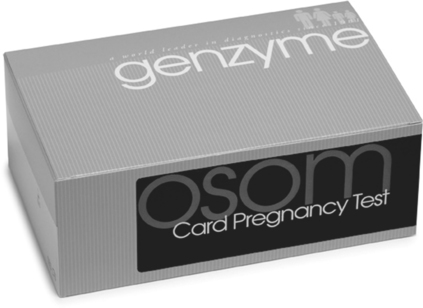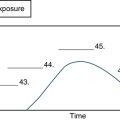Point-of-Care Testing
At the conclusion of this chapter, the reader should be able to:
• Define point-of-care testing (POCT).
• Cite some advantages and disadvantages of POCT.
• Differentiate among the four different types of testing categories.
• Correctly answer case study related multiple choice questions.
• Be prepared to participate in a discussion of critical thinking questions.
• Describe the principle and clinical application of one POCT assay.
Testing Categories
1. Waived tests. Simple procedures with little chance of negative outcomes if performed inaccurately.
2. Moderately complex tests. More complex than waived tests but usually automated (e.g., enzyme immunoassays).
3. Highly complex tests. Usually nonautomated or complicated tests requiring considerable judgment (e.g., serum protein electrophoresis).
4. Provider-performed microscopy tests. Slide examinations of freshly collected body fluids.
Test complexity is determined by criteria that assess knowledge, training, reagent and material preparation, operational technique, QC-QA characteristics, maintenance and troubleshooting, and interpretation and judgment. Any over-the-counter test approved by the U.S. Food and Drug Administration (FDA) is automatically placed into the “waived” category. POCT falls within the “waived” or “moderately complex” category.
Quality Control Standards
The Centers for Disease Control and Prevention (CDC; www.cdc.gov) has invited providers to participate in a new performance evaluation program (HIV Rapid Testing MPEP) that offers the external evaluation of rapid tests for human immunodeficiency virus (e.g., OraQuick Rapid HIV-1 Antibody Test) and other licensed tests (e.g., MedMira Reveal Rapid HIV-1 Test).
 Card Pregnancy Test∗
Card Pregnancy Test∗
Principle
The OSOM Card Pregnancy Test (Fig. 9-1) is a solid-phase, sandwich-format, immunochromatographic assay for the qualitative detection of human chorionic gonadotropin (hCG).
See ![]() website for the procedural protocol.
website for the procedural protocol.
Limitations
• This assay is capable of detecting only whole-molecule (intact) hCG. It cannot detect the presence of free hCG subunits. Therefore, this test should only be used for the qualitative detection of hCG in urine for the early determination of pregnancy.
• For diagnostic purposes, hCG test results should always be used with other methods and in the context of the patient’s clinical information (e.g., medical history, symptoms, results of other tests, clinical impression). An ectopic pregnancy cannot be distinguished from normal pregnancy by hCG measurements alone.
• If the hCG level is inconsistent with or unsupported by clinical evidence, results should also be confirmed by an alternative hCG method. Test results should be confirmed using a quantitative hCG assay before any critical medical procedure.
• Interfering substances may falsely depress or falsely elevate results. These interfering substances may cause false results over the entire range of the assay, not only at low levels, and may indicate the presence of hCG when there is none. As with any immunochemical reaction, unknown interferences from medications or endogenous substances may affect results.
• Infrequently, hCG levels may appear consistently elevated and could be caused by, but are not limited to, the following:
• Trophoblastic neoplasms or nontrophoblastic neoplasms. These abnormal physiologic states may falsely elevate hCG levels and should not be diagnosed with this test.
• Because of the high degree of sensitivity of the assay, specimens tested as positive during the initial days after conception may later be negative because of natural termination of the pregnancy.
• Overall, natural termination occurs in 22% of clinically unrecognized pregnancies and 31% of other pregnancies. In the presence of weakly positive results, it is good laboratory practice to sample and test again after 48 hours.
• If the test band appears very faint, it is recommended that a new sample be collected 48 hours later and tested again using another OSOM Card Pregnancy Test device.
• Dilute urine specimens may not have representative levels of hCG.
• Detection of very low levels of hCG does not rule out pregnancy; low levels of hCG can occur in apparently healthy nonpregnant subjects. Additionally, postmenopausal specimens may elicit weak positive results because of low hCG levels unrelated to pregnancy. In a normal pregnancy, hCG values double approximately every 48 hours. Patients with very low levels of hCG should be sampled and tested again after 48 hours, or tested with an alternative method.
• Some antipsychotic drugs are known to cause false-positive results in pregnancy tests.
Cross-Reactivity
| Interfering Substance | Concentration |
| Acetaminophen | 20 mg/dL |
| Acetoacetic acid | 2000 mg/dL |
| Acetylsalicylic acid | 20 mg/dL |
| Amitriptyline | 100 mg/dL |
| Amphetamines | 10 µg/mL |
| Ascorbic acid | 20 mg/dL |
| Atropine | 20 mg/dL |
| Benzoylecgonine | 10 mg/dL |
| Bilirubin | 2 mg/dL |
| Caffeine | 20 mg/dL |
| Cannabinol | 10 mg/dL |
| Chlorpromazine | 5 mg/dL |
| Codeine | 10 mg/dL |
| Desipramine | 20 mg/dL |
| Diazepam | 2 mg/dL |
| Ephedrine | 20 mg/dL |
| Estradiol | 25 ng/mL |
| Estriol | 1 mg/dL |
| Ethanol | 200 mg/dL |
| Gentisic acid | 20 mg/dL |
| Glucose | 2000 mg/dL |
| Hemoglobin | 250 mg/dL |
| Human albumin | 2000 mg/dL |
| β-Hydroxybutyrate | 2000 mg/dL |
| Ibuprofen | 40 mg/dL |
| Imipramine | 100 mg/dL |
| Lithium | 3.5 mg/dL |
| Methadone | 10 mg/dL |
| Mesoridazine | 1 mg/dL |
| Morphine | 6 µg/mL |
| Nortriptyline | 100 mg/dL |
| Phenobarbital | 15 mg/dL |
| Phenylpropanolamine | 20 mg/dL |
| Pregnanediol | 1500 µg/dL |
| Progesterone | 40 ng/mL |
| Proteins | 2000 mg/dL |
| Salicylic acid | 20 mg/dL |
| Tetracycline | 20 mg/dL |
| Thioridazine | 2 mg/dL |
Adapted from OSOM Card Pregnancy Test, Philadelphia, 2007, Genzyme Diagnostics.
Chapter Highlights
• Point-of-care testing (POCT) involves laboratory assays performed near the patient and includes home test kits and handheld monitors.
• The major advantage of POCT is the rapidity of assay results; the major drawback is cost.
• Testing can be divided into waived, moderately complex, highly complex, and provider-performed microscopy tests. POCT is in the waived or moderately complex category.
• State and city governments may enact mandatory POCT regulations that are more stringent than federal regulations.
• Written POCT policies and procedures must be available to all laboratory personnel.
• The greatest source of POCT error is preanalytic errors.
• Most POCT is done by manual rapid tests (e.g., pregnancy testing).




